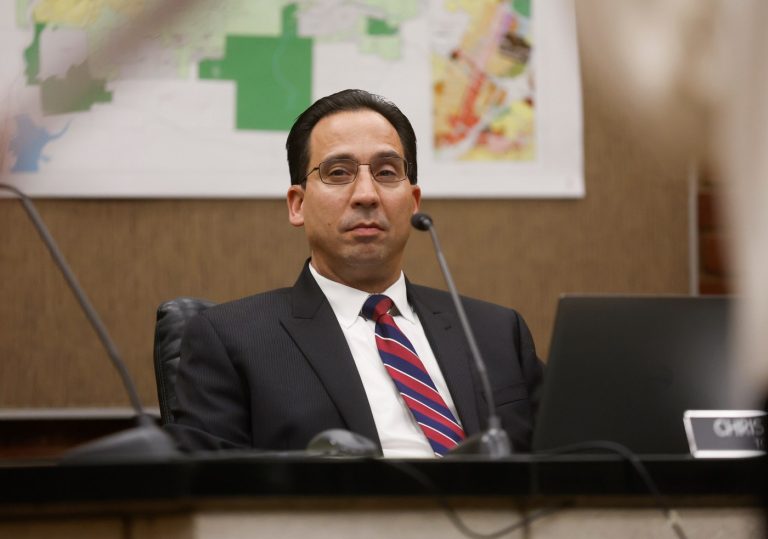San Diego’s loss is San Jose’s gain as Gov. Gavin Newsom has decided to rescind a $10 million grant to the Southern California county for new tiny home shelters, instead giving most of the money to the Bay Area’s largest city.
In a letter this week to San Diego County, the state said local officials voided the grant agreement by declining to approve the site selected for the new tiny homes for homeless residents. On Wednesday, San Jose officials said they were set to receive an additional $6.7 million for a planned 100-bed tiny home site on Cherry Avenue near the Guadalupe River.
“San Diego County could not move with the urgency the housing and homelessness crisis demands,” Newsom’s office said in a statement. “The governor is committed to accountability, and we will not allow local delays and opposition to impede the state’s unprecedented efforts to get people off the streets and into housing.”
The governor’s office did not immediately respond to questions about why the state chose to give the money to San Jose. It was unclear what would happen to the remainder of the $10 million grant.
The new funding for San Jose comes on top of a $12.7 million tiny home grant it received earlier this year — after Newsom reneged on a promise to deliver 200 prefabricated cabin shelters to the city.
“I’m grateful for Governor Newsom’s strong support to help San Jose address the urgent homelessness crisis on our streets,” said San Jose Mayor Matt Mahan in a statement. “This new allocation for small homes will help us provide safe, interim housing for our most vulnerable residents.”
San Jose has an estimated 6,340 homeless residents, about 4,400 of whom are unsheltered on the city’s streets or living in vehicles.
In a statement to Politico, which first reported Newsom’s decision, San Diego County Board of Supervisors Chairwoman Nora Vargas said the board vetoed the plan to add 150 tiny home beds in response to “my community’s feedback and concerns.”
“I’m glad we were able to come together as a community to explore solutions and other options within our county,” Vargas said. “I look forward to collaborating with Governor Newsom to find real and equitable solutions to the homelessness crisis and will continue to ensure that community voices are heard throughout this process.”
On Wednesday, local media in San Diego reported the county had approved a new tiny home site in hopes of potentially winning back the $10 million grant. It was unclear if the city had a realistic path to getting the funding.
Newsom’s move follows recent pledges he’s made to hold local governments accountable for spending state homelessness dollars, including announcing new oversight measures and briefly withholding millions in funding meant for cities. But a scathing audit earlier this year found California officials were responsible for failing to track whether the $24 billion the state has spent on homelessness in recent years is helping alleviate the crisis.
San Jose, the target of an accompanying state audit that found similar flaws in the city’s homelessness response, has been at the forefront of embracing tiny homes as a solution to homelessness. Since 2020, the city has developed six tiny home sites with around 500 beds, and three planned sites could soon double that total.
Tiny home proponents contend the “interim” shelters, which provide rent-free private units on a temporary basis, are more stable and welcoming alternatives to traditional group shelters that lack privacy and generally have lower placement rates to housing.
Yet as the city faces a severe affordable housing shortage, not everyone finds lasting homes. According to city data, only about half of the roughly 1,380 residents who moved through the sites as of May had transitioned to permanent housing, and results varied widely between locations.
Related Articles
Judge allows Oakland to clear homeless encampment in early test of Supreme Court ruling
California passed a law to fix unsafe homeless shelters. Cities and counties are ignoring it
What would Biden’s proposed 5% nationwide rent cap mean for the Bay Area?
After SCOTUS homelessness ruling, here’s how Bay Area advocates plan to halt encampment sweeps
Kneaded culinary academy cooks up solutions for struggling South Bay youth
While tiny homes are far quicker and less expensive to build than permanent affordable housing, some homeless advocates argue shifting too many resources toward shelter options is a short-sighted strategy that will be costly in the long run.
San Jose expects to spend $25 million next year on its portfolio of tiny homes. And if the city follows through on plans to add 784 more beds within the next 18 months, officials estimate the cost of operating the sites could balloon to $70 million by 2028.
Even so, Mahan has pushed the city to move full steam ahead on building more tiny homes. He argues that scaling up shelter options is crucial to solving street homelessness — and for following through on a state-mandated plan to clear about 1,000 unhoused people from city waterways.
“The city is committed to moving quickly to ensure these homes are built and occupied as quickly as possible,” he said. “This crisis can’t wait.”












